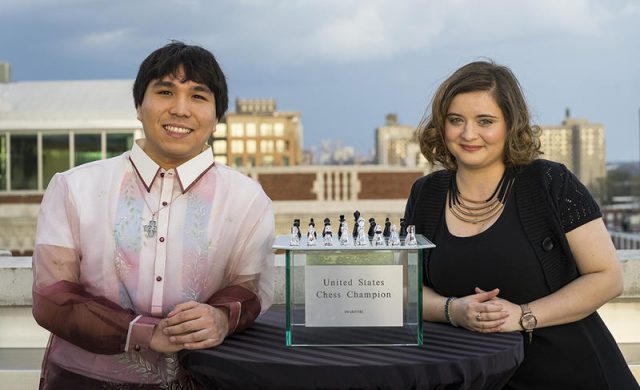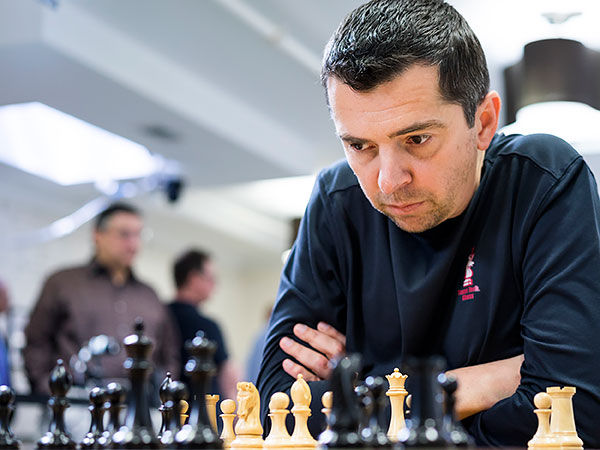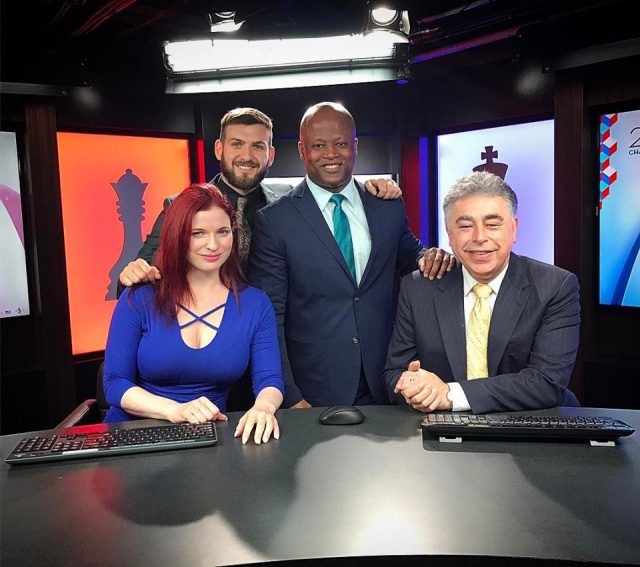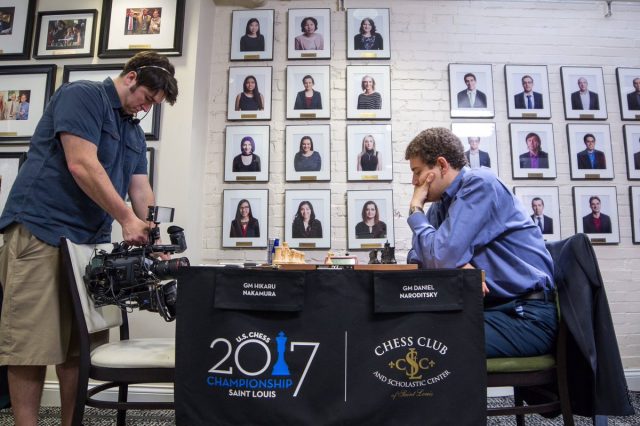Just like last year, I list the ten biggest takeaways from the 2017 U.S. Championships. It’s great to see this tournament becoming stronger and more exciting every year, and once again the event delivered.
- Sabina Foisor’s U.S. Women’s Championship is one of the greatest stories in U.S. Championship History
If you asked people before the tournament “Who do you think will win the U.S. Women’s Title”, there is no chance that Sabina would be mentioned as even one of the top four names. She was rated 6th in a field of 12, and had never had an especially impressive performance in the event before, despite many appearances throughout the years. When you combine her underdog status with the personal tragedy she endured with her mother’s unexpected passing, her win against all odds was even more awe inspiring. The moment when she officially became the U.S. Women’s Championship and embraced with her fiancé, Elshan Moradiabadi, was the most emotional scene I’ve ever seen in my career in chess. https://twitter.com/USChess/status/851199578271608832 Not only did she win the tournament but she did so in fantastic style, with a queen sacrifice that is certainly going to go down as one of the most memorable combinations in U.S. Women’s Chess Championship history.
[pgn] [Event "U.S. Women's Championship"] [Date "2017.04.09"] [White "Virkud, Apurva"] [Black "Foisor, Sabina-Francesca"] [Result "0-1"] [WhiteElo "2262"] [BlackElo "2272"] [PlyCount "62"] [EventDate "2017.??.??"] [WhiteTeam "United States"] [BlackTeam "United States"] [WhiteTeamCountry "USA"] [BlackTeamCountry "USA"] [WhiteClock "0:16:54"] [BlackClock "0:29:16"] 1. d4 Nf6 2. c4 e6 3. Nc3 Bb4 4. Qc2 O-O 5. Nf3 c5 6. dxc5 Na6 7. c6 bxc6 8. g3 d5 9. Bd2 d4 10. Ne4 Rb8 11. Nxf6+ Qxf6 12. Bg2 e5 13. O-O Bf5 14. Qc1 Bxd2 15. Qxd2 h6 16. Qa5 c5 17. b3 e4 18. Nd2 Rfe8 19. Rad1 Rb6 20. Nb1 Qe7 21. e3 Bg4 22. Rd2 Nb4 23. exd4 e3 24. fxe3 Qxe3+ 25. Kh1 Rf6 26. Rg1 Qxg1+ 27. Kxg1 Re1+ 28. Bf1 Rfxf1+ 29. Kg2 Rg1+ 30. Kf2 Ref1+ 31. Ke3 Rf3+ 0-1 [/pgn]It was hard to find a single person rooting against Sabina, and I think this even includes many of her rivals in the tournament.
- The class and grace of the top finishers in the U.S. Championship was a great example to chess players across the world.
Up until the very end of the tournament, things looked great for Nazi Paikidze in her quest for a repeat as U.S. Champion. However her last round loss to the rising star, Jennifer Yu, put an end to her championship quest. I am sure that this loss must have been painful for her, but it seemed like it was just a matter of minutes before she logged onto Twitter to send a heartfelt congratulations to Sabina for winning the title. https://twitter.com/NaziPaiki/status/851203907472830464 U.S Champion Wesley So was a complete gentleman as always. In each of his post game interviews, the main impression you get was that his opponent was possibly the most talented and skilled chess player to ever play the game, and that it was an amazing feat that Wesley was able to win. Wesley always pays massive compliments to his opponents, and this is not something he does only when he wins. While it’s been a while since he’s lost a game (67 and counting), I am certain that you would see the same grace and class from Wesley should he have lost to Onischuk in the playoff.
- Don’t ever underrate the veterans
I made a terrible mistake in my prediction piece, and I think it’s a common one. We are all mystified by the talent of young stars, but probably we are too biased in their direction. However a tournament like the U.S. Championship requires more than just talent. The experience of playing in this type of tournament for over a decade is really beneficial. It was clear that a veteran like Alex Onischuk relied on this experience and that they specifically used it to defeat some of their younger opponents.
Onischuk’s victories against the younger Jeffery Xiong and Ray Robson were pretty one sided games in which Onischuk’s preparation and understanding really shined through. While players like Xiong and Shankland are unquestionably very strong, it’s rare that you see them win games with the poise that Onischuk won those two games.
[pgn] [Event "ch-USA 2017"] [Site "Saint Louis USA"] [Date "2017.04.08"] [Round "10.3"] [White "Onischuk, Alexander"] [Black "Xiong, Jeffery"] [Result "1-0"] [ECO "D85"] [WhiteElo "2667"] [BlackElo "2674"] [PlyCount "103"] [EventDate "2017.03.29"] 1. d4 Nf6 2. c4 g6 3. Nc3 d5 4. cxd5 Nxd5 5. e4 Nxc3 6. bxc3 Bg7 7. Nf3 c5 8. Be3 Bg4 9. Rc1 O-O 10. Be2 Qa5 11. Qd2 cxd4 12. cxd4 Nc6 13. Qxa5 Nxa5 14. h3 Bxf3 15. Bxf3 Rfc8 16. Ke2 e5 17. dxe5 Bxe5 18. Bg4 Rc4 19. f4 Bb2 20. Rxc4 Nxc4 21. Bf2 Re8 22. Bf3 Na3 23. Rd1 Rc8 24. e5 Bc1 25. Bxb7 Rc2+ 26. Kf3 Bd2 27. Bd5 Nb5 28. Bb3 Rb2 29. g3 Nc3 30. Ra1 a5 31. e6 fxe6 32. Bxe6+ Kf8 33. Bc5+ Kg7 34. Bd4+ Kf8 35. Bb3 Ke8 36. Rf1 a4 37. Bxc3 Bxc3 38. Bxa4+ Kf8 39. Bb3 Bd2 40. Rf2 Bc3 41. Rxb2 Bxb2 42. Ke4 Ba3 43. Ke5 Ke7 44. g4 Bd6+ 45. Ke4 Ba3 46. Bg8 h6 47. h4 Kf6 48. Bb3 Ke7 49. g5 hxg5 50. hxg5 Kf8 51. Kf3 Kg7 52. Kg4 1-0 [/pgn]
[pgn] [Event "ch-USA 2017"] [Site "Saint Louis USA"] [Date "2017.04.06"] [Round "8.4"] [White "Onischuk, Alexander"] [Black "Robson, Ray"] [Result "1-0"] [ECO "D85"] [WhiteElo "2667"] [BlackElo "2668"] [PlyCount "129"] [EventDate "2017.03.29"] 1. d4 Nf6 2. c4 g6 3. Nc3 d5 4. cxd5 Nxd5 5. e4 Nxc3 6. bxc3 Bg7 7. Nf3 c5 8. Be3 Qa5 9. Qd2 O-O 10. Rc1 Nd7 11. Bd3 b6 12. O-O e6 13. Qe2 Bb7 14. Nd2 Qxa2 15. Ra1 Qb2 16. Rfb1 Qxc3 17. Nc4 Nf6 18. Ra3 Nxe4 19. Bxe4 Bxe4 20. Rxc3 Bxb1 21. Rc1 cxd4 22. Bg5 d3 23. Qd2 Rfc8 24. Rxb1 Rxc4 25. Qxd3 Rc5 26. h4 h5 27. Rd1 Rd5 28. Qf3 Rxd1+ 29. Qxd1 a5 30. Qf3 Ra7 31. Be3 Rc7 32. Bxb6 Rc1+ 33. Kh2 Rc4 34. g3 a4 35. Qa8+ Kh7 36. Qa7 Kg8 37. Qa6 Rb4 38. Bc5 Rb8 39. Qxa4 Bf6 40. Qf4 Rc8 41. Qxf6 Rxc5 42. Qd8+ Kh7 43. Qf8 Rf5 44. Kg2 Rf6 45. Kf1 Rf5 46. Ke2 e5 47. Kf1 Rf6 48. Kg2 Rf5 49. f3 Rf6 50. Qe7 Rf5 51. g4 hxg4 52. fxg4 Rf4 53. Kg3 Rf1 54. Qxe5 Rg1+ 55. Kf3 Rb1 56. Qd4 Rc1 57. Kf4 Re1 58. Qb4 Rf1+ 59. Ke5 Kg7 60. Kd6 Rf6+ 61. Kd7 Re6 62. Qc4 g5 63. h5 Re5 64. Qd4 f6 65. Kd6 1-0 [/pgn]I am sure that Xiong, Shankland and other young stars have many bright U.S. Championships ahead of them, but it’s clear to me now that so do the veterans of U.S. Chess.
- The WildCard selection couldn’t have been better:
In both tournaments the Saint Louis Chess Club and Scholastic Center did a great job of choosing the wildcards. In the U.S. Championship, Yaro Zherebukh showed that he is a fearsome competitor who can knock off anyone in the event. His win over Fabiano Caruana was one of the turning points of the event.
[pgn] [Event "ch-USA 2017"] [Site "Saint Louis USA"] [Date "2017.04.05"] [Round "7.2"] [White "Zherebukh, Yaroslav"] [Black "Caruana, Fabiano"] [Result "1-0"] [ECO "C95"] [WhiteElo "2605"] [BlackElo "2817"] [PlyCount "101"] [EventDate "2017.03.29"] 1. e4 e5 2. Nf3 Nc6 3. Bb5 a6 4. Ba4 Nf6 5. O-O Be7 6. Re1 b5 7. Bb3 d6 8. c3 O-O 9. h3 Nb8 10. d4 Nbd7 11. Nbd2 Bb7 12. Bc2 Re8 13. Nf1 Bf8 14. Ng3 g6 15. a4 c5 16. d5 c4 17. Bg5 h6 18. Be3 Nc5 19. Qd2 h5 20. Bg5 Bg7 21. Rf1 Qc7 22. Bh6 Bh8 23. Ng5 Nh7 24. Nxh7 Kxh7 25. Be3 Qe7 26. f4 exf4 27. Bxf4 Kg8 28. Rf3 Bg7 29. Raf1 Nd7 30. Bh6 Bxh6 31. Qxh6 Qf8 32. Qd2 Ne5 33. Rf6 Rad8 34. Qg5 Qg7 35. Bd1 Bc8 36. Qh4 Kf8 37. Qf4 Qg8 38. Kh1 Re7 39. Bxh5 bxa4 40. Bd1 Qg7 41. Bxa4 Qh7 42. Qg5 a5 43. Kg1 Qh8 44. R1f4 Qg7 45. Rh4 Nd3 46. Rh6 Ne5 47. Rf4 Bd7 48. Qh4 Kg8 49. Qxe7 Re8 50. Qg5 Bxa4 51. Rf6 1-0[/pgn]Yaro finished up with a solid 50% score, which is well above the type of performance you’d expect from a wildcard selection.
In the Women’s Championship, Maggie Feng got her first chance to play. There was no question she deserved it after her impressive first place finish in the National Junior High K-9 Championship. However she even managed to one up Yaro by finishing with an awesome +1 score. Maggie’s play was noticeably more solid than many young players, as she drew many of her games with relative ease, while taking advantage of small advantages in other games. Her play and attitude is so inspiring that she even has a fan club. https://twitter.com/USChess/status/850771959797489665
- The five young girls who competed in the U.S. Women’s Championship were an inspiration
While everyone is generally friendly at the U.S. Championships, they are sometimes a bit aloof until the tournament has concluded. This wasn’t the case with the young girls playing in the U.S. Women’s however. They are all great friends with each other, and it seemed as if they were not only playing in a major chess tournament, but also attending a summer camp and getting to spend time with their friends. It’s also clear that this attitude didn’t hurt them much, as both Jennifer Yu and Maggie Feng finished with impressive +1 scores. Feng even gained over 100 FIDE rating points at the tournament.  From their matching jackets to their fun trips to the World Chess Hall of Fame, it’s great to see people not just playing an important chess tournament but also having so much fun and building lifelong friendships!
From their matching jackets to their fun trips to the World Chess Hall of Fame, it’s great to see people not just playing an important chess tournament but also having so much fun and building lifelong friendships!
 Maggie Feng, Vanessa Sun, Emily Nguyen, Carissa Yip, Jennifer Yu and Apurva Virkud at the World Chess Hall of Fame POW exhibit.
Maggie Feng, Vanessa Sun, Emily Nguyen, Carissa Yip, Jennifer Yu and Apurva Virkud at the World Chess Hall of Fame POW exhibit.- Not only can Wesley So win, but he can do it in style
It’s without question that the best game of the entire event was Wesley So’s fantastic victory over Jeffery Xiong in Round 9. Let’s keep in mind that Wesley was black in this game and was facing a talented young player. There were only three rounds to go, and it’s quite probable that without a victory Wesley would not have become U.S. Champion.
[pgn] [Event "ch-USA 2017"] [Site "Saint Louis USA"] [Date "2017.04.07"] [Round "9.1"] [White "Xiong, Jeffery"] [Black "So, Wesley"] [Result "0-1"] [ECO "E06"] [WhiteElo "2674"] [BlackElo "2822"] [PlyCount "62"] [EventDate "2017.03.29"] 1. d4 Nf6 2. c4 e6 3. g3 d5 4. Bg2 Be7 5. Nf3 O-O 6. O-O dxc4 7. Qc2 a6 8. a4 Bd7 9. Rd1 Bc6 10. Nc3 Bxf3 11. Bxf3 Nc6 12. Bxc6 bxc6 13. Bg5 Rb8 14. e3 c5 15. dxc5 Qe8 16. Rd4 Nd7 17. Bxe7 Qxe7 18. c6 Ne5 19. Qe4 Qc5 20. Nd5 Nd3 21. Nxc7 Nxf2 22. Kxf2 Rxb2+ 23. Kf1 Qh5 24. Qg4 Qxh2 25. Qf3 c3 26. Rc1 e5 27. Rh4 Qd2 28. Rd1 Rd8 29. Nd5 Rxd5 30. Rd4 Rxd4 31. exd4 Qxd1+ 0-1 [/pgn]Much to the delight of chess fans around the world, Wesley produced an absolute masterpiece, which will go down as one of the greatest games in U.S. Championship history.
- Never Give Up
If there was one chess lesson to be learned from this tournament it was clearly that anything is possible. The second most memorable game from the event must certainly be the Round 9 showdown between Var Akobian and Fabiano Caruana. Fabiano knew that he needed a win to get right back into the thick of things, and managed to outplay Var from a relatively dry opening. With a clear two extra pawns in a late middlegame, it was obvious to everyone that Fabiano would win and be right back into the U.S Championship hunt.
[pgn] [Event "ch-USA 2017"] [Site "Saint Louis USA"] [Date "2017.04.07"] [White "Akobian, Varuzhan"] [Black "Caruana, Fabiano"] [Result "1-0"] [ECO "A41"] [WhiteElo "2645"] [BlackElo "2817"] [PlyCount "157"] [EventDate "2017.03.29"] 1. d4 d6 2. Nf3 Nf6 3. c4 g6 4. Nc3 Bf5 5. e3 Bg7 6. Bd3 Bxd3 7. Qxd3 O-O 8. O-O Nbd7 9. b3 e5 10. dxe5 dxe5 11. Ba3 Re8 12. Ne4 Nxe4 13. Qxe4 Qc8 14. Rad1 Nf6 15. Qc2 e4 16. Nd4 Ng4 17. Bb2 Ne5 18. Ne2 Qg4 19. Nf4 Qf5 20. Rd2 c6 21. Rfd1 h5 22. h3 h4 23. Rd6 Bh8 24. c5 a5 25. a3 Kh7 26. Qe2 Bg7 27. Qc2 Bh8 28. Kf1 Re7 29. Rd8 Rxd8 30. Rxd8 Bf6 31. Qd2 a4 32. Qc2 axb3 33. Qxb3 Nd7 34. Qc2 Kg7 35. Ne2 Qxc5 36. Bxf6+ Kxf6 37. Nc3 Kg7 38. Kg1 Qxa3 39. Qd2 Nf6 40. Qd4 Qa1+ 41. Kh2 Qa5 42. Kg1 Qe5 43. Qb4 b6 44. Ne2 Qc7 45. Ra8 c5 46. Qb2 Rd7 47. Ra1 Rd6 48. Nc3 Qe7 49. Nb5 Rd3 50. Rb1 Qe6 51. Nc7 Qd7 52. Qxb6 c4 53. Nb5 Rd1+ 54. Rxd1 Qxd1+ 55. Kh2 Qd5 56. Nd4 Nd7 57. Qd8 Qd6+ 58. Kg1 c3 59. Kh1 Qd5 60. Kg1 Qb7 61. Qe7 Kg8 62. Qe8+ Nf8 63. Qa4 Qb1+ 64. Kh2 Qe1 65. Qc6 Qd2 66. Kg1 Nh7 67. Qc8+ Kg7 68. Qc7 Qe1+ 69. Kh2 Qxf2 70. Qxc3 Kh6 71. Nc6 Qg3+ 72. Kh1 Qc7 73. Qc5 Qc8 74. Qd6 Qf5 75. Ne5 Kg7 76. Qd4 f6 77. Qa7+ Kh6 78. Ng4+ Kg5 79. Qxh7 1-0 [/pgn]I went to the gym at some point around that moment and came back to the almost impossible news that Fabiano lost. I knew that the Internet wouldn’t be lying to me but I just couldn’t fathom how such a thing is possible. Fabiano is rated above 2800 and was up a clear two pawns. However Var kept fighting and fighting and eventually a common mistake occurred……in mutual time trouble, and unable to accept any result except for a win, Fabiano overlooked his opponent’s counterchances and lost the game. In the U.S. Women’s Tournament you saw a similar example in the Round 10 game between Abrahamyan and Paikidze. Abrahamyan was up a pawn and looked well on her way to victory, when time trouble reared it’s ugly head and Paikidze pulled off a surprising comeback victory.
[pgn] [Event "U.S. Women's Championship"] [Date "2017.04.08"] [Round "10.1"] [White "Abrahamyan, Tatev"] [Black "Paikidze, Nazi"] [Result "0-1"] [WhiteElo "2364"] [BlackElo "2369"] [PlyCount "74"] [EventDate "2017.??.??"] [WhiteTeam "United States"] [BlackTeam "United States"] [WhiteTeamCountry "USA"] [BlackTeamCountry "USA"] [WhiteClock "0:00:53"] [BlackClock "0:09:29"] 1. e4 g6 2. d4 Bg7 3. Nc3 d6 4. f4 a6 5. Nf3 b5 6. Bd3 Nd7 7. d5 Nc5 8. O-O b4 9. Ne2 Nf6 10. Ned4 Bb7 11. Qe2 O-O 12. a3 bxa3 13. Rxa3 a5 14. c4 Nxd3 15. Qxd3 Nd7 16. b3 Nc5 17. Qc2 e6 18. Bd2 exd5 19. exd5 Qf6 20. f5 h6 21. Rxa5 Rae8 22. Ra7 Bc8 23. Rxc7 Bxf5 24. Nxf5 gxf5 25. b4 Ne4 26. b5 Ng5 27. Nxg5 hxg5 28. Qd3 f4 29. h4 Qd4+ 30. Qxd4 Bxd4+ 31. Kh2 Re2 32. Bb4 Kg7 33. Rd1 Be5 34. Kg1 g4 35. Rc6 g3 36. b6 Ra8 37. Re1 Bd4+ 0-1 [/pgn]While Caruana and Abrahamyan certainly had some role in their tragic losses, it couldn’t have been possible without the determined resistance of both Akobian and Paikidze.
- The Broadcast gets better and better each year
Once again the live Broadcast is a fun and entertaining show. There is a huge staff of people working on it behind the scenes (Spectrum Studios and Silverback Productions) and the professionalism level is at an absolute high. Alongside the main commentary team of Maurice Ashley, Cristian Chirila, Yasser Seirawan, and Jennifer Shahade, there was a Spanish broadcast led by Lili Fuentes and a live show led by Eric Hansen and Ben Finegold.
One underrated aspect of the show is their intelligent use of breaks and switching scenes. I cannot tell you how mindnumbing it can be to comment on 4-5 hour chess games nonstop without a break. Some other shows use this format and it not only results in obvious fatigue from the hosts, but also makes it a less enjoyable experience for those hosts. If the hosts aren’t having fun, it’s harder to do a good job.
In this show the commentators switch back and forth between the personalities: Yasser and Jenn will talk about the position, Maurice will come on with some exciting breaking news and engine analysis, then there may be an awesome quick segment by Christian Chirila, followed up by an interview led by Maurice Ashley. In the slow time control games I have even almost come around to the idea that using engine analysis isn’t a horrible idea, as it’s a long show and it’s nice to mix it up AFTER you have heard actual human analysis on a position. My one criticism however is that using engine analysis on blitz, rapid games or during time scrambles presents an extremely unrealistic picture of what is actually happening in the minds of the players. I would recommend a lot more discussion of “the engine says this but there is no way that any human is going to recognize this in a fast game, and therefore the line basically doesn’t exist in reality”. During the rapid playoff I felt that frequently the engine analysis overshadowed the real practical truth of what was happening in the game. Too often I heard a computer line being discussed and within seconds I thought to myself “Ok the computer says that but who cares, there’s zero chance either player is playing those moves”, yet precious commentary time was being wasted on these irrational variations. So yes, I do believe there can be a place for engine analysis in broadcasts, but it requires a lot of careful explanation and understanding to present the practical meaning of what the engines are saying.
- Having a women’s tournament alongside an open tournament is a great idea
Can you imagine how much more boring the tournament would have been if it was just the 12 players in the U.S. Championship? Fans around the world were simply captivated by all the stories in the U.S. Women’s Championship. This engagement should be a signal that the days of just holding one big tournament should stop. https://twitter.com/rajachess/status/850805298369613824 An example of my idea: There shouldn’t just be a “Sinquefield Cup”. There should be a “Sinquefield Cup” and a “Women’s Sinquefield Cup”. I don’t know exactly what types of players should be in the Women’s event, but it’s clear that if Women’s tournaments are promoted properly, they engage and excite the fans just as much as the Open tournament does. Let’s use this obvious truth and build on it. Women should not always be playing segregated events, so I also like the idea of coming up with some mixed field events, i.e- Veterans vs. Women or the K v Q event that the Saint Louis Chess Club had in 2009, early in its organizing and broadcasting history.
It’s so important for chess fans to see a mixture of both men and women playing. I cannot overstate how this helps build a stronger and healthier subculture.
- I can’t wait for the 2018 U.S. Championships!
Although the sad thing is that not all of the players who played this year will also get to play next year. I have no idea which players in particular will be left out, but in my mind they all played an important role in the Championship. While I am sure we will see some new names in 2018, and while that will be refreshing, it will also be sad to see which players don't make the cut. Because as we saw from this year, it’s really not easy to predict who will win this event just by looking at their rating. Imagine what we would have lost if someone like Onischuk, Akobian, Foisor or spoiler extraordinaire, Jennifer Yu, didn’t even qualify for the event! Think about how much less interesting this year’s tournament would have been. 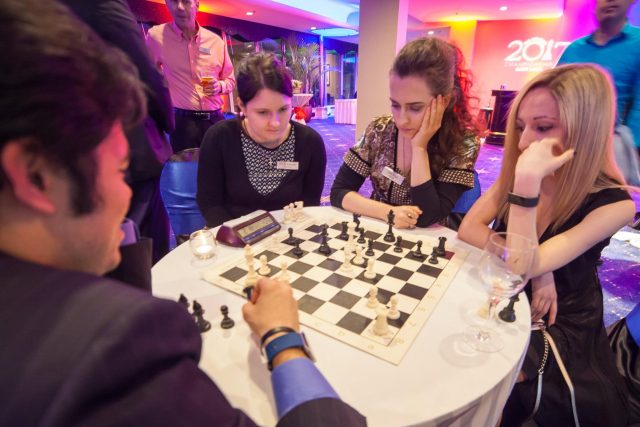 There is something special about the U.S. Championship that brings out the best in everyone. For nearly every American chess player it’s the most important tournament of the year. With all of their energy focused on this event, it’s possible for players to have results that far exceed what you would expect by just looking at their rating. Bravo to the St. Louis Chess Club and Scholastic Center for putting together such an exciting field of players every year. To anyone who’s read my articles, it’s no secret that I enjoy watching rapid chess more than slower time control games, but the U.S. Championship is perhaps the one and only tournament where I still feel engaged by the storylines and intrigue even though the time control is so slow.
There is something special about the U.S. Championship that brings out the best in everyone. For nearly every American chess player it’s the most important tournament of the year. With all of their energy focused on this event, it’s possible for players to have results that far exceed what you would expect by just looking at their rating. Bravo to the St. Louis Chess Club and Scholastic Center for putting together such an exciting field of players every year. To anyone who’s read my articles, it’s no secret that I enjoy watching rapid chess more than slower time control games, but the U.S. Championship is perhaps the one and only tournament where I still feel engaged by the storylines and intrigue even though the time control is so slow.
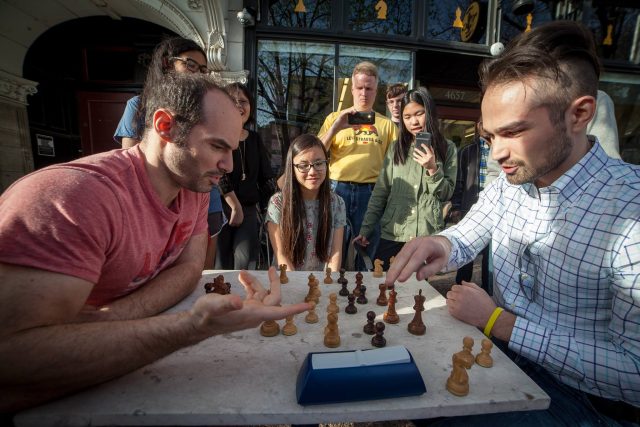 IM Greg Shahade playing blitz without a board against GM Mesgen Amanov, with Apurva Virkud, Emily Nguyen and Carissa Yip watching, Photo Eric Rosen
IM Greg Shahade playing blitz without a board against GM Mesgen Amanov, with Apurva Virkud, Emily Nguyen and Carissa Yip watching, Photo Eric Rosen Follow IM Greg Shahade on YouTube, twitter and look for his takeover of the @USChess feed during SuperNationals VI in Nashville.
Categories
Archives
- January 2026 (2)
- December 2025 (27)
- November 2025 (29)
- October 2025 (39)
- September 2025 (27)
- August 2025 (29)
- July 2025 (43)
- June 2025 (25)
- May 2025 (24)
- April 2025 (29)
- March 2025 (29)
- February 2025 (20)
- January 2025 (24)
- December 2024 (34)
- November 2024 (18)
- October 2024 (35)
- September 2024 (23)
- August 2024 (27)
- July 2024 (44)
- June 2024 (27)
- May 2024 (31)
- April 2024 (51)
- March 2024 (34)
- February 2024 (25)
- January 2024 (26)
- December 2023 (29)
- November 2023 (26)
- October 2023 (37)
- September 2023 (27)
- August 2023 (37)
- July 2023 (47)
- June 2023 (33)
- May 2023 (37)
- April 2023 (45)
- March 2023 (37)
- February 2023 (28)
- January 2023 (31)
- December 2022 (23)
- November 2022 (32)
- October 2022 (31)
- September 2022 (19)
- August 2022 (39)
- July 2022 (32)
- June 2022 (35)
- May 2022 (21)
- April 2022 (31)
- March 2022 (33)
- February 2022 (21)
- January 2022 (27)
- December 2021 (36)
- November 2021 (34)
- October 2021 (25)
- September 2021 (25)
- August 2021 (41)
- July 2021 (36)
- June 2021 (29)
- May 2021 (29)
- April 2021 (31)
- March 2021 (33)
- February 2021 (28)
- January 2021 (29)
- December 2020 (38)
- November 2020 (40)
- October 2020 (41)
- September 2020 (35)
- August 2020 (38)
- July 2020 (36)
- June 2020 (46)
- May 2020 (42)
- April 2020 (37)
- March 2020 (60)
- February 2020 (38)
- January 2020 (45)
- December 2019 (34)
- November 2019 (35)
- October 2019 (42)
- September 2019 (45)
- August 2019 (56)
- July 2019 (44)
- June 2019 (35)
- May 2019 (40)
- April 2019 (48)
- March 2019 (61)
- February 2019 (39)
- January 2019 (30)
- December 2018 (29)
- November 2018 (51)
- October 2018 (45)
- September 2018 (29)
- August 2018 (49)
- July 2018 (35)
- June 2018 (31)
- May 2018 (39)
- April 2018 (31)
- March 2018 (26)
- February 2018 (33)
- January 2018 (30)
- December 2017 (26)
- November 2017 (24)
- October 2017 (30)
- September 2017 (30)
- August 2017 (31)
- July 2017 (28)
- June 2017 (32)
- May 2017 (26)
- April 2017 (37)
- March 2017 (28)
- February 2017 (30)
- January 2017 (27)
- December 2016 (29)
- November 2016 (24)
- October 2016 (32)
- September 2016 (31)
- August 2016 (27)
- July 2016 (24)
- June 2016 (26)
- May 2016 (19)
- April 2016 (30)
- March 2016 (36)
- February 2016 (28)
- January 2016 (32)
- December 2015 (26)
- November 2015 (23)
- October 2015 (16)
- September 2015 (28)
- August 2015 (28)
- July 2015 (6)
- June 2015 (1)
- May 2015 (2)
- April 2015 (1)
- February 2015 (3)
- January 2015 (1)
- December 2014 (1)
- July 2010 (1)
- October 1991 (1)
- August 1989 (1)
- January 1988 (1)
- December 1983 (1)


